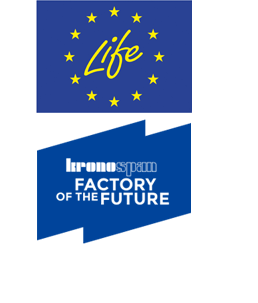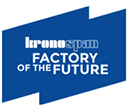Reduction of the water footprint
The water footprint, a concept defined in 2002 by Professor Arjen Hoekstra (source Wikipedia: https://en.wikipedia.org/wiki/Water_use#Water_footprint) is an indicator based on the actual consumption of fresh water at the different stages of production of a product by consumers or manufacturers.
The ultimate objective of Kronospan is to reduce tap water consumption by 70-75% compared with 2010 consumption by several different means:
- Increasing the efficiency of the water distribution system, reducing losses by renewing, replacing and insulating pipework and the adjacent equipment.
- Collecting and using rainwater and recycled water from the production process.
Installing measuring equipment
Water losses were identified following the installation in 2012 of a dozen electromagnetic flowmeters, allowing environmental managers at Kronospan to monitor the daily flow of water through pipes. This measurement equipment significantly simplifies the identification of faults and aids their repair, resulting in major savings in tap water costs.
Installation of the condensation recycling circuit
The heat exchangers used in the production process are also an important source of condensation. The estimated quantity of water that could be saved is in the order of 30 000 m3 a year. Based on this finding, engineers at Kronospan have installed all the necessary equipment for operation of the condensation recycling circuit: direct condenser, heat exchange plate, intermediate water storage tanks, pumps and pipes to channel the condensation through the factory.
Installation of the rainwater capture system
Full rainwater quality analyses were carried out during the summer of 2013 by experts from the Luxembourg Institute of Science and Technology. The installation of capture and filtration equipment began in February 2014 and a retention system used to separate out fine particles from the surface of the water was installed in July 2014. Since autumn 2014 the quality of all rain/surface waters is monitored in real time with a continuous analysis and automatic sampler station. In total, it was estimated that 127 000 m3 of rainwater water per year could be collected, however its quality is not suitable for more sensitive process use.
New building roofs connected to the water circuit
A new extension building (July 2014), with a roof area of 14 000 m2 was connected to the water recycling circuit.
Installation of the rainwater capture system
Full rainwater quality analyses were carried out during the summer of 2013 by experts from the Luxembourg Institute of Science and Technology. The installation of capture and filtration equipment began in February 2014 and a retention system used to separate out fine particles from the surface of the water was installed in July 2014. Since autumn 2014 the quality of all rain/surface waters is monitored in real time with a continuous analysis and automatic sampler station. In total, it was estimated that 127 000 m3 of rainwater water per year could be collected, however its quality is not suitable for more sensitive process use.
New building roofs connected to the water circuit
A new extension building (July 2014), with a roof area of 14 000 m2 was connected to the water recycling circuit.
Extension of the surface water collection
The installation of a surface collector on the western log yard (started in November 2015, ended in February 2016) added a collection capacity of 5 000m3/month.
Reduction of the carbon footprint
Natural gas consumption had to be reduced in several stages by 90% compared with 2010, which also helped to lower CO2 emissions by 80%. Two approaches were used to reduce the carbon footprint:
- Optimising the energy consumption of processes and equipment,
- Increasing the use of wood energy for thermal energy production.
Optimisation
Changes to existing equipment were focused on modification of the existing boiler in order to increase its efficiency by at least 5%.
Improvements to the boiler began in June 2012 as they could only be carried out during periodic stoppages of the MDF and OSB production lines.
Optimisation of the burners and the boiler resulted in a reduction in the consumption of natural gas during operational use. Modifications made to the MDF particle/dust burner reduced the consumption of natural gas by two-thirds. Physical and electronic modifications were made during 2015 and 2016 at the OSB burner level. As a result, the wood-energy ratio increased to 90% of total OSB dryer fuel used.
The installations were insulated and cleaned to increase their efficiency.
Installation of additional equipment
In July 2014, a new unit for the sampling (Option 2 of the pre-study), classification and disintegration of recycled wood was ordered. This unit is used to transform wood residues into fine particles compatible with the burners, making possible to recycle a larger quantity of wood waste from the production cycle.
In the last year of the project, a CHP (Option 1 of the pre-study) of 40 MW (8 MW for electricity) is built. At the end of the project, around 85% of the CHP was installed; being fully functional in June 2017. Once its operation fully optimised, the CHP helps in reaching and sometimes surpassing the goals of the project, concerning the use of wood, the decrease in carbon and water footprint, and green electricity supply to the national grid.
New procedures
The zone surrounding the OSB pre-heater is cleaned every week and heat exchanger plate maintenance is carried out regularly by a specialised team.
Factory monitoring
Control actions are used to assess the operational efficiency of the Factory of the Future. These assessments are carried out by collecting and analysing general and specific data.
Operation of the Factory of the Future is monitored and controlled in accordance with the European Union Emissions Trading System (EU ETS).
Energy consumption control
Gas consumption is measured using mechanical or electric meters. The main meter is provided by the company CREOS. Two additional meters were installed in the new data collection system set up during the project.
Gas emissions control
Emission controls are carried out annually in accordance with the Luxembourg regulation governing atmospheric emissions. These controls are conducted with the help of Mueller-BBM and BTL.
Water quality and quantity controls
Various parameters are analysed in order to evaluate water quality, such as its pH, hardness and conductivity. These analyses are carried out every two weeks. The volumes of tap water consumed are checked daily using electronic measurement equipment.
Production quality and quantity control
The overall Kronospan’ production, expressed in cubic meters, increased in 2016 by 8% compared to 2010 (reference year of the project).
The quality of products is checked by an internal laboratory or by an accredited organisation. Production sustainability is confirmed by the use of PEFC or FSC certified timber.
The quality of products is checked by an internal laboratory or by an accredited organisation. Production sustainability is confirmed by the use of PEFC or FSC certified timber.
Internal test series are conducted by Kronospan (3 test series a day) for MDF and OSB products: bending stiffness and strength (EN 310, EN 321, EN 319), humidity (EN 322), bulk density (EN 325). The other parameters were tested less frequently: once a day for swelling after immersion in water (EN 317) and once per MDF and OSB production cycle for formaldehyde release (EN 120).
In accordance with the standard EN 325, the technical specifications were tested by external organisations (WKI, CITBH) twice a year for each board thickness (3 OSB, 3 MDF, 1 HDF). Tests were also conducted internally by Kronospan for the conductivity, pH and hardness of the water used by steam generators 1 and 2.
Environmental evaluation
The wood-energy consumption is covered for the largest part by on-site sources; however is expected that at full CHP functioning in the long run about 40% (preferably by-products) to be purchased from external sources. Consequently, special attention was given to the management of the supply chain from a lifecycle perspective, in order to increase the availability of the raw material without pressuring on forests’ cycle and minimizing the transport distances.
A Life Cycle Analysis (LCA) was carried out by the Luxembourg Institute of Science and Technology on representative products from the OSB and MDF production lines in order to validate the end products. The LCA examined the entire production chain (cradle-to gate), from the arrival of raw materials to delivery of the finished product.
A Carbon Footprint Analysis (CFA) of the production site was made in order to complement a previous BTL´s Carbon Footprint Analysis of Kronospan’ products.
Dissemination of results
Dissemination activities and their focus on the significant environmental benefits of the project allow visibility of the project. A wide spectrum of stakeholders (including Kronospan group itself) was covered, ranging from the general public and end-users to important actors from the wood-panel industry, the wood waste suppliers, R&D community or local and national authorities.
Life Cycle Management Conference 2017
Life Cycle Management (LCM) Conference, takes place in Luxembourg, 3-6 September 2017. LCM is the main, biennial, world event of the Life Cycle Assessment community. Kronospan is a platinum sponsor of LCM 2017 and from this position inform this audience, initially targeted, of the methods implemented and the results obtained during the project and after its ending, in the frame of the LIFE+ programme.

